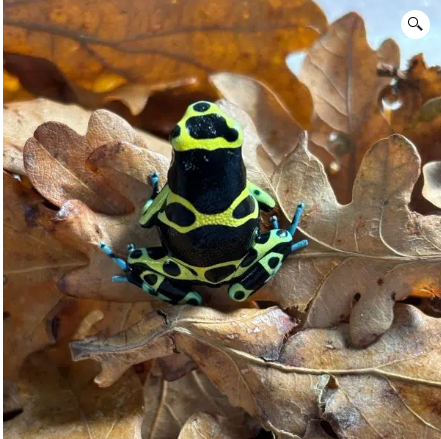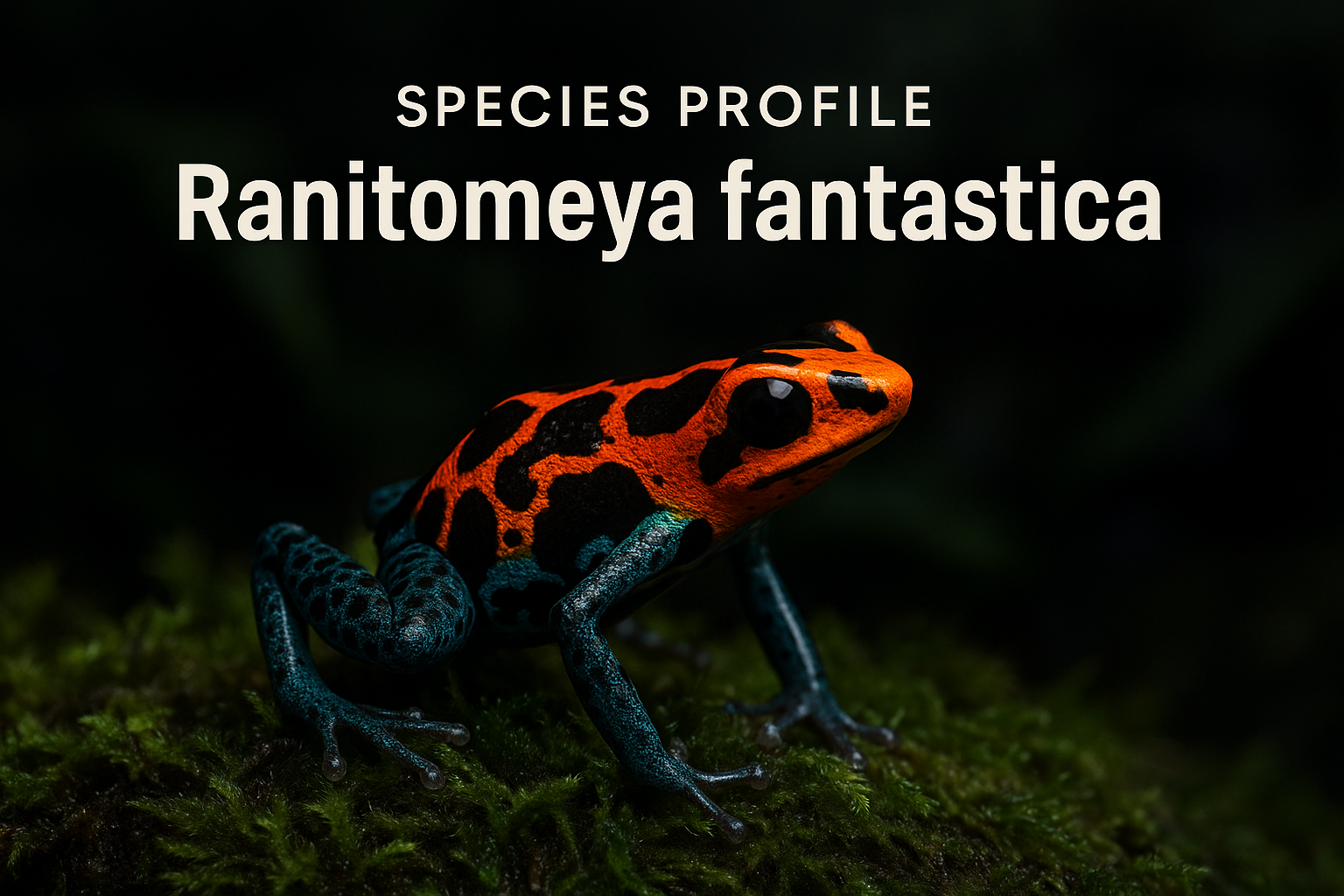Meet the Dendrobates tinctorius ‘Lucemalia Blue-Foot’
The Dendrobates tinctorius ‘Lucemalia Blue-Foot’ is a spectacular dart frog morph that instantly captivates anyone who sees it. Known for its golden-yellow body, jet-black patterns, and unmistakable cobalt-blue feet, this morph — affectionately called the Blue-Foot Luc — is one of the most striking frogs you can add to a bioactive collection.
Origin and Discovery
Like other tinctorius morphs, the Lucemalia Blue-Foot hails from the dense rainforests of northern South America. It’s not a separate species, but a local colour form celebrated for its dramatic contrast and calm nature. The name ‘Lucemalia’ likely stems from the Latin lucem (light), a nod to the way their blue legs shimmer under natural daylight — a trait that sets this morph apart from the Netted and Banded variants.
Appearance and Identification
The Blue-Foot Lucemalia displays a bold, high-contrast look: a bright yellow back interlaced with deep black bands, framed by vivid blue legs and feet. Each individual frog’s pattern is unique, and under LED or natural lighting, their blue hues almost seem to glow. Adults grow up to 5 cm in length and carry themselves with the steady confidence typical of larger D. tinctorius morphs.
Behaviour and Personality
Lucemalia Blue-Foots are calm, visible, and surprisingly interactive. They’re diurnal, meaning they’re active during the day, and they’ll often climb onto leaves or moss patches to survey their surroundings. Their calls are soft and infrequent — more a quiet buzz than a loud trill — making them perfect for display vivariums in homes or offices.
Vivarium Setup and Care
To keep your Blue-Foot Luc thriving, maintain a steady temperature between 22–25°C and humidity around 80–100%. They love complex setups with vertical space, leaf litter, and mossy textures. A bioactive vivarium is the best choice, as it provides both stability and enrichment.
If you’re building your first setup, our four custom Euro Vivariums are ideal for maintaining visibility, humidity, and airflow. For comparison, you might also like the closely related Blue Foot Dart Frog (Dendrobates leucomelas ‘Cerro Autana’ juveniles), which shares some of the same bold blue features.
Feeding and Supplements
The Lucemalia Blue-Foot is an enthusiastic feeder. Offer a mix of fruit flies, springtails, and isopods to maintain energy and growth. Their pigmentation, especially in the legs, is enhanced by a balanced supplement routine.
We recommend alternating between products from our Microfauna Foods & Supplements section — such as Repashy Calcium Plus, SuperPig, and a monthly vitamin A dose — to keep your frogs healthy and radiant.
Breeding Dendrobates tinctorius ‘Lucemalia Blue-Foot’
When mature, males begin to call softly to attract females. Breeding often takes place inside bromeliads, on leaf litter, or even within small hides. After fertilisation, males typically guard the eggs until hatching. Once tadpoles emerge, they can be moved to small grow-out tubs and raised on spirulina or specialist tadpole foods.
Under proper conditions, metamorphosis takes roughly 80–90 days, revealing juveniles with their signature blue feet already developing.
Why Choose the Blue-Foot Lucemalia?
These frogs are ideal for anyone seeking a colourful, visible species that thrives in a naturalistic setup. The Lucemalia Blue-Foot is calm enough for daytime observation but still full of personality. Their slow, confident movements make them the centrepiece of any vivarium display.
Quick Facts
- Scientific name: Dendrobates tinctorius ‘Lucemalia Blue-Foot’
- Common name: Blue-Foot Luc
- Size: 5 cm
- Origin: Northern South America
- Temperature: 22–25°C
- Humidity: 80–100%
- Temperament: Calm, visible, confident
- Diet: Fruit flies, springtails, isopods
Frequently Asked Questions about Dendrobates tinctorius ‘Lucemalia Blue-Foot’
Are Lucemalia Blue-Foot dart frogs suitable for beginners?
Yes — they’re a great choice for keepers who have mastered basic dart frog husbandry. Their calm temperament and hardiness make them forgiving and rewarding.
What temperature and humidity do Lucemalia Blue-Foots need?
Keep them at 22–25°C with 80–100% humidity. Mist regularly to maintain moisture and promote natural activity.
Can I keep multiple Lucemalia Blue-Foots together?
Yes, in pairs or trios — but avoid housing multiple males in small enclosures to prevent territorial behaviour.
What do Lucemalia Blue-Foots eat?
They eat fruit flies, springtails, and isopods, supplemented with calcium and vitamins from the Microfauna Foods & Supplements range.
Do Lucemalia Blue-Foots need UVB lighting?
Low-level UVB (2–5%) supports calcium metabolism and helps maintain vibrant blue pigmentation, but it’s optional if you supplement correctly.



